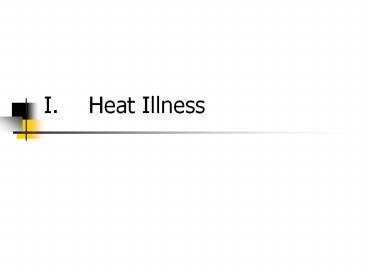Heat Illness - PowerPoint PPT Presentation
Title: Heat Illness
1
Heat Illness
2
- Core Temperature Temperature of brain, heart and
lungs and abdominal organs. - Shell Temperature Temperature of skin and
muscles - Normal core temperature 98.6 degrees F
- core temperatures are fatal above 100 degrees F
- Humidity and wind affect temperature (higher
humidity the higher the temperature and vice
versa) - when outside temperatures exceeds 80 degrees F
sweating is how the body dissipates heat - Larger and overweight people are more prone to
heat illness
- Ways the body cools off
- Sweating
- capillaries open causing redness and release heat
- Drinking cool water helps regulate body
temperature.
3
- Importance of Water
- Body 75 water
- Heart 80 water
- Brain 80 water
- Muscles 75 water
- Skin 70 water
- For each pound lost during exercise 16oz of
water - Dehydration tests
- If you are thirsty then you are already
dehydrated - Dark color urine
- Pinch test, looking for skin rebound
4
- Types of heat illness
- Hyperthermia temperature above 101 degrees F
2nd most frequent cause of sports death - Heat Cramp Muscle fatigue and spasms (lack of
water or electrolyte imbalance)
5
- Heat Exhaustion Cause Excessive depletion of
fluids and electrolytes (salt, potassium and
magnesium) due to profuse sweating.
- Signs/Symptoms
- Excessive thirst
- Weakness (gradual)
- Nausea
- light headedness
- Headache
- Anxiety
- Dizziness
- Fainting
- profuse sweating
- cold and clammy skin
- pale or grayish skin
- weak and rapid pulse
- fast shallow respiration
- core temperature is near normal
- low blood pressure
6
- Treatment for heat exhaustion
- Have athlete lie down in a cold place and drink
liquids - Remove excess clothing and rub athletes body with
a cool, wet towel - Instruct athlete to stay out of heat for the rest
of the day - Replace lost water and salt
- Take to hospital if complications develop
- Athletes are very susceptible to having heat
illness again.
7
- Heat Stroke Cause Overheating due to a
breakdown of the thermoregulartory system.
MEDICAL EMERGENCY! LIFE THREATENING! - Signs/Symptoms
- extreme headache
- extreme weakness
- Nausea
- serious disorientation
- warm dry skin
- lack of sweating
- rapid full pulse
- high core temperature
- Unconsciousness
- seizures
- coma
8
- Treatment for heat stroke
- Chance for survival depends on how rapidly help
is received THIS IS A TRUE EMERGENCY CALL 911 - Get athlete out of sun
- Cool body immediately by spraying with cold
water, applying cool and wet towels, and fanning.
- Full body immersions in cold water if possible,
examples cold whirl pool or cool bath tub - Place ice or cold packs under arms and groin
area.
9
- Preventing Heat Illness
- Each athlete should have a physical exam with a
medical history or previous heat illness
- Educate the athlete - full disclosure of the
risk, prevention and treatment of heat illness - Know the physical condition of the athletes and
set practice schedules accordingly - Acclimatization- becoming accustomed to
exercising in hot temperatures which usually
takes 10 to 14 days - Drink fluids before, during and after exercise
- Intensity of workout lowered during high heat
periods. Workout in cooler part of the day - Water should be available in unlimited
quantities, cold water empties into the intestine
faster - Water breaks every 15-20 minutes with rest, force
fluids
10
- Increase salt intake and electrolyte beverages
- Keep weight records athlete should not lose more
than 3 to 5 of body weight during practice.
Drink quart of water per pound lost - Know both the temperature and humidity readings,
(wet bulb/sling psychrometer) - Eat a well balanced diet, fat intake should be
minimal - Wear lightweight uniforms on high temperature
days - Never wear rubberized clothing
- Observe athletes carefully for signs of heat
illness
11
END OF HEAT ILLNESSES































